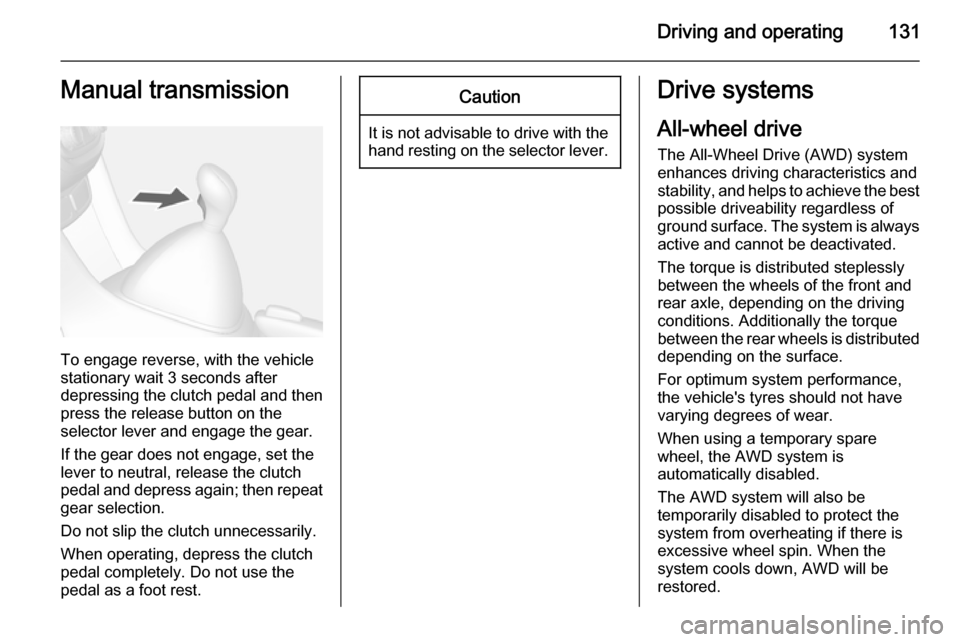automatic transmission OPEL MOKKA 2014 Manual user
[x] Cancel search | Manufacturer: OPEL, Model Year: 2014, Model line: MOKKA, Model: OPEL MOKKA 2014Pages: 217, PDF Size: 6 MB
Page 133 of 217

Driving and operating131Manual transmission
To engage reverse, with the vehicle
stationary wait 3 seconds after
depressing the clutch pedal and then press the release button on the
selector lever and engage the gear.
If the gear does not engage, set the
lever to neutral, release the clutch
pedal and depress again; then repeat
gear selection.
Do not slip the clutch unnecessarily.
When operating, depress the clutch
pedal completely. Do not use the
pedal as a foot rest.
Caution
It is not advisable to drive with the hand resting on the selector lever.
Drive systems
All-wheel drive
The All-Wheel Drive (AWD) system
enhances driving characteristics and
stability, and helps to achieve the best possible driveability regardless of
ground surface. The system is always
active and cannot be deactivated.
The torque is distributed steplessly
between the wheels of the front and rear axle, depending on the driving
conditions. Additionally the torque
between the rear wheels is distributed
depending on the surface.
For optimum system performance,
the vehicle's tyres should not have
varying degrees of wear.
When using a temporary spare
wheel, the AWD system is
automatically disabled.
The AWD system will also be
temporarily disabled to protect the
system from overheating if there is
excessive wheel spin. When the
system cools down, AWD will be
restored.
Page 138 of 217

136Driving and operating
accelerated or decelerated to a speed
between 5 and 20 km/h. When DCS
is active, u flashes.
DCS will only be activated on roads with a certain incline.
Deactivation
DCS is deactivated if the vehicle is
decelerated below 2 km/h or
accelerated above 35 km/h.
Switching off
Press button u again. Control
indicator u extinguishes.
At speeds above 60 km/h the system
is switched off automatically.Driver assistance
systems9 Warning
Driver assistance systems are
developed to support the driver
and not to replace the driver's
attention.
The driver accepts full
responsibility when driving the
vehicle.
When using driver assistance
systems, always take care
regarding the current traffic
situation.
Cruise control
The Cruise control can store and
maintain speeds of approx. 30 to
200 km/h. Deviations from the stored
speeds may occur when driving uphill or downhill.
It is the responsibility of the driver to
comply with local posted speed limits.
For safety reasons the cruise control
cannot be activated until the foot
brake has been operated once.
Activating in first gear is not possible.
Do not use the cruise control if it is not advisable to maintain a constant
speed.
With automatic transmission, only
activate cruise control in automatic
mode.
Control indicator m 3 89.
Switching on
Press button m: control indicator m in
instrument cluster illuminates white.
Page 188 of 217

186Vehicle careJump startingDo not start with a quick charger.
A vehicle with a discharged battery
can be started using jump leads and the battery of another vehicle.9 Warning
Be extremely careful when starting
with jump leads. Any deviation
from the following instructions can
lead to injuries or damage caused
by battery explosion or damage to the electrical systems of both
vehicles.
9 Warning
Avoid contact of the battery with
eyes, skin, fabrics and painted
surfaces. The fluid contains
sulphuric acid which can cause
injuries and damage in the event
of direct contact.
■ Never expose the battery to naked flames or sparks.
■ A discharged battery can alreadyfreeze at a temperature of 0 °C.
Defrost the frozen battery before
connecting jump leads.
■ Wear eye protection and protective
clothing when handling a battery.
■ Use a booster battery with the same voltage (12 Volts). Its
capacity (Ah) must not be much less than that of the discharged
battery.
■ Use jump leads with insulated terminals and a cross section of at
least 16 mm 2
(25 mm 2
for diesel
engines).
■ Do not disconnect the discharged battery from the vehicle.
■ Switch off all unnecessary electrical
consumers.
■ Do not lean over the battery during jump starting.
■ Do not allow the terminals of one lead to touch those of the other
lead.
■ The vehicles must not come into contact with each other during the
jump starting process.■ Apply the parking brake, transmission in neutral, automatictransmission in P.
■ Open the positive terminal protection caps of both batteries.
Lead connection order:
1. Connect the red lead to the positive terminal of the booster
battery.
2. Connect the other end of the red lead to the positive terminal of the
discharged battery.
Page 190 of 217

188Vehicle care
Screw in the towing eye as far as it will
go until it stops in a horizontal
position.
Attach a tow rope – or better still a tow
rod – to the towing eye.
The towing eye must only be used for towing and not for recovering the
vehicle.
Switch on ignition to release steering
wheel lock and to permit operation of
brake lights, horn and windscreen
wiper.
Transmission in neutral.
Caution
Never tow your vehicle equipped
with All Wheel Drive (AWD) with the front or rear tyres on the road.
If you tow the vehicle equipped with AWD while the front or rear
tyres are rolling on the road the
drive system in the vehicle could
be severely damaged. When
towing vehicles equipped with
AWD all 4 tyres may not be in
contact with the road.
Caution
Drive slowly. Do not drive jerkily.
Excessive tractive force can
damage the vehicle.
When the engine is not running,
considerably more force is needed to
brake and steer.
To prevent the entry of exhaust gases from the towing vehicle, switch on the
air recirculation system 3 116 and
close the windows.
Vehicles with manual transmission:
The vehicle must be towed facing
forwards. The maximum speed is
80 km/h . In all other cases, and when
the transmission is defective, the front axle must be raised off the ground.
Vehicle with automatic transmission:
Do not tow the vehicle using tow eye.
Towing with a tow rope could cause
severe automatic transmission
damage. When towing vehicle with
automatic transmission, use flat bed or wheel lift equipment.
Seek the assistance of a workshop.
After towing, unscrew the towing eye.
Insert cap and close cap.
Page 204 of 217
![OPEL MOKKA 2014 Manual user 202Technical dataPerformanceEngineA14NETA16XERA18XERA17DTSMaximum speed2)
[km/h]Manual transmission186170180190/185 3)Automatic transmission––1801842)
The maximum speed indicated is achievable at OPEL MOKKA 2014 Manual user 202Technical dataPerformanceEngineA14NETA16XERA18XERA17DTSMaximum speed2)
[km/h]Manual transmission186170180190/185 3)Automatic transmission––1801842)
The maximum speed indicated is achievable at](/img/37/18890/w960_18890-203.png)
202Technical dataPerformanceEngineA14NETA16XERA18XERA17DTSMaximum speed2)
[km/h]Manual transmission186170180190/185 3)Automatic transmission––1801842)
The maximum speed indicated is achievable at kerb weight (without driver) plus 200 kg payload. Optional equipment
could reduce the specified maximum speed of the vehicle.
3) Vehicles with All-wheel drive system.
Page 205 of 217
![OPEL MOKKA 2014 Manual user Technical data203Vehicle weight
Kerb weight, basic model without any optional equipmentEngineManual transmissionAutomatic transmissionwithout/with air conditioning
[kg]A14NET1414/1425–A16XER1324/133 OPEL MOKKA 2014 Manual user Technical data203Vehicle weight
Kerb weight, basic model without any optional equipmentEngineManual transmissionAutomatic transmissionwithout/with air conditioning
[kg]A14NET1414/1425–A16XER1324/133](/img/37/18890/w960_18890-204.png)
Technical data203Vehicle weight
Kerb weight, basic model without any optional equipmentEngineManual transmissionAutomatic transmissionwithout/with air conditioning
[kg]A14NET1414/1425–A16XER1324/1335–A18XER1349/13601446/1457A17DTS1418/14291421/1432A17DTS 4)1479/1490–
Kerb weight, basic model with all optional equipment
EngineManual transmissionAutomatic transmissionwithout/with air conditioning
[kg]A14NET–/1534–A16XER–/1444–A18XER–/1461–/1558A17DTS–/1538–/1541A17DTS 4)–/1599–4)
Vehicles with All-wheel drive system.
Page 212 of 217

210IndexAAccessories and vehicle modifications .......................... 153
Adaptive forward lighting .....88, 108
Adjustable air vents ...................119
Airbag and belt tensioners ...........84
Airbag deactivation ................47, 84
Airbag system .............................. 42
Air conditioning regular operation ................................ 120
Air conditioning system .............. 116
Air intake .................................... 120
Air vents...................................... 119
All-wheel drive ........................... 131
Antilock brake system ................ 132
Antilock brake system (ABS) .......86
Anti-theft alarm system ................26
Anti-theft locking system .............. 25
Appearance care ........................190
Automatic anti-dazzle ..................29
Automatic light control ...............105
Automatic locking ........................24
Automatic transmission .............128
Auxiliary heater ........................... 119
B Battery discharge protection ......114
Battery voltage ............................. 96
Bicycle rack .................................. 58Bonnet ....................................... 155
Bonnet open ................................. 89
Brake and clutch fluid .................194
Brake and clutch system .............85
Brake assist ............................... 133
Brake fluid .................................. 158
Brakes ............................... 132, 158
Breakdown.................................. 187
Bulb replacement ....................... 161
C
Capacities .................................. 205
Catalytic converter .....................127
Central locking system ................22
Centre console storage ...............57
Centre high-mounted brake light 166
Changing tyre and wheel size ...177
Charging system .......................... 85
Child locks ................................... 24
Child restraint installation locations ................................... 50
Child restraints.............................. 48
Child restraint systems ................48
Climate control ............................. 16
Climate control systems .............115
Clock ............................................ 77
Code ............................................. 94
Control indicators.......................... 82
Control of the vehicle .................121
Controls ........................................ 73